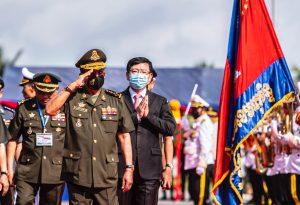Around twelve months ago, the U.S. Defense Department was confident enough in its intelligence to state in its annual “Report on Military and Security Developments Involving the People’s Republic of China” that the Ream Naval Base in Cambodia “will be the PRC’s first overseas base in the Indo-Pacific.” But give an eye to the Pentagon’s same report for this year, published in late October. There are seven mentions of Cambodia, but not one states that Ream will be a Chinese base. In fact, the Pentagon’s only comments this time are that “in June 2022, a PRC official confirmed that the PLA would have access to parts of Cambodia’s Ream Naval Base.”
On the surface, this appears to be something of a climb down, from the entire site being a Chinese overseas base (as the 2022 report implied) to just the PLA having access to parts of it, presumably the parts that Phnom Penh and Beijing have openly admitted that China is rebuilding.
As far as I am aware, the different tones of these two reports haven’t been highlighted in the media. Nor, indeed, has there been coverage of the apparent change of leadership at Ream Naval Base. Until May, Cambodia’s state media was still referring to Adm. Ouk Seiha as commander of the base. However, following a visit by a Russian vessel in late November, media reported that Rear Adm. Mey Dina was commander of the base. (Rear Adm. Ros Veasna now appears to be deputy commander.) A local news article from 2022 referred to Mey Dina as having previously been a spokesperson for the Navy’s site and, as far as I can make out, the deputy commander at the base. This could be simply a result of poor reporting, although in early November a reporter at UCANews referred to “speculation of a management shake-up at the Ream Naval Base.”
Presumably, this change took place around the time of Cambodia’s general election in July and the vast generational succession process that took place the following month, in which Prime Minister Hun Sen resigned (as did most ruling party grandees) and handed over power to his eldest son, Hun Manet, the former army commander and deputy commander of the military.
Perhaps Ouk Seiha was shuffled out as commander of Ream for a prosaic reason. From what I can work out, he had been commander of the base since the late 1990s, if not earlier, so presumably he was approaching the age of retirement. He was also associated last year with a scandal involving the tycoon Te Taing Por, president of the Federation of Associations for Small and Medium Enterprises of Cambodia, and the apparent sale of military land, as documented by Voice of Democracy. The navy accused the tycoon of illegally acquiring 120 hectares of land near the base. The tycoon said he bought it legally in 1997 with Ouk Seiha’s permission.
Ouk Seiha at some point in time apparently tried to sue the tycoon, but the Supreme Court ruled in the tycoon’s favor. Interestingly enough, Mey Dina, now the apparent commander of the base, also made an appearance last year when, still head of the Navy’s property management committee, he alleged that the tycoon had bribed the Supreme Court for the favorable verdict, a rare occasion when someone within the system cries foul about corruption. The navy was particularly incensed with this case, repeatedly calling on the tycoon to stop spreading “fake news” and “attempting to humiliate” naval chiefs.
The Hun family controls Cambodia’s army; Hun Manet was the army chief, a post now occupied by Mao Sophan, the head of Hun Sen’s praetorian guard. Hun Manet’s brother, Hun Manith, the military intelligence chief, was also promoted to deputy army commander this year. Meanwhile, the navy has long been controlled by the Tea family. Tea Banh was defense minister from 1987 until August of this year when he resigned and handed over power to his son, Tea Seiha. Tea Vinh, Tea Banh’s brother, is the navy chief. (He is one of the few Cambodians to have been sanctioned by the United States.)
This division of power doesn’t appear to have changed. When Chinese warships docked for the first time at Cambodia’s Ream Naval Base earlier this month, Tea Seiha and his father welcomed them. Tea Banh, now a privy councilor but still the patriarch of the Tea family, reviewed a row of Chinese naval officers. Hun Manet was also present. As The Associated Press reported, the news of this visit “came out indirectly, through a Facebook post on Sunday by Cambodian Defense Minister Tea Seiha. It said he visited the base to see preparations for Cambodian navy training and to inspect progress on infrastructure construction, but did not mention China by name.”
Such secrecy won’t go down well in Washington, which has spent years alleging that Phnom Penh has signed a secret deal with Beijing to allow the People’s Liberation Army use of the base. (Indeed, there wasn’t such furtiveness when the British warship, HMS Spey, visited the base in February or when a Japanese navy delegation visited in 2022, both occasions on which Phnom Penh made a clear song and dance as a way to refute U.S. allegations.)
Judging by the latest comments from American officials, including from the State Department this month, their concern is now about Chinese control of a particular part of the base, such as the new China-funded pier. Whether that’s any less concerning to the likes of Vietnam and the Philippines depends on whether China can now be credibly deterred from its military intentions in the South China Sea, since clearly there was a failure to deter Beijing from expanding its capacity, not least since Ream offers it another staging post between the mainland and the South China Sea.

































